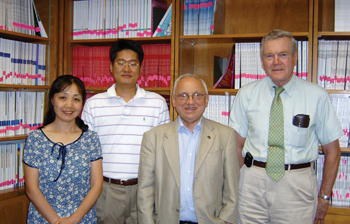
Researchers (from left) Danya Liu, M.D., Daewoong Jo, Ph.D., Jacek Hawiger, M.D., Ph.D., and Robert Collins, M.D., have developed a new type of protein therapy that fights acute inflammation.
Protein therapy ‘SOCS’ it to inflammation
An inflammation-fighting protein, designed by Vanderbilt University Medical Center researchers, can break through the barriers of the cell membrane and shield cells from internal injury and possible death.
In the August issue of Nature Medicine, a research team led by Jacek Hawiger, M.D., Ph.D., reports that this cell-penetrating protein prevents inflammation-induced organ injury and dramatically increases survival of mice exposed to inflammation-causing toxins.
This strategy, called intracellular protein therapy, may provide a new way to treat inflammation-associated illnesses and organ failure, a serious consequence of acute inflammation.
Inflammation is nature's innate anti-microbial defense system. In response to foreign invaders (bacteria, viruses, parasites, etc.) or to chemicals, the innate immune system produces alarm signals — cytokines and chemokines — that fight these disease-causing agents and help tissues heal.
Inflammation is usually self-limiting, and these alarm-sounding mediators are squelched by physiologic inhibitors.
“We have a very fine-tuned mechanism inside our cells to produce physiologic inhibitors of inflammation, called suppressors of cytokine signaling (SOCS),” said Hawiger, the Oswald T. Avery Distinguished professor and chair of Microbiology and Immunology.
As the inflammation-causing agent is sensed by cells, SOCS proteins are produced inside the cells to extinguish the inflammatory signals. However, SOCS proteins are rapidly degraded together with their targets, often before they can eliminate the excessive inflammatory signaling. In turn, lingering and uncontrolled cytokines can cause massive organ damage.
“We thought that if we could find a way to replenish these useful physiologic proteins by designing a replacement and deliver this replacement to the cells, then we can attenuate the inflammatory response, which is noxious and contributes to the failure of multiple organs (liver, kidney, lung and heart),” Hawiger said.
To meet this challenge, Daewoong Jo, Ph.D., postdoctoral fellow in Microbiology and Immunology and other members of Hawiger's team, had to design a cell-penetrating version of the SOCS protein.
To help guide SOCS through the cell membrane, Hawiger and colleagues attached the chemical equivalent of a drill bit to the end of the physiologic anti-inflammatory protein. They then injected the engineered protein, called CP-SOCS3, into mice and determined which tissues granted the protein entry.
The protein penetrated cells in the liver, spleen, lung, heart and kidney, the primary organs affected by acute inflammation. The protein was detectable for at least eight hours in the immune cells of these tissues and in some cases persisted for up to 24 hours after a single injection.
To determine the protein's effectiveness in abating inflammation, Hawiger and colleagues administered the protein to mice that had been exposed to three different agents, including two microbial toxins. These toxins cause massive inflammatory liver injury and are often fatal.
The researchers found that the engineered protein suppressed levels of pro-inflammatory cytokines, protected liver cells, and dramatically increased survival.
“We foresee that this type of therapy would be applicable for treatment of acute inflammation of the liver (as happens in viral hepatitis), the lung (which complicates blood poisoning, or sepsis) and the kidneys (which can be damaged by toxin-producing E. coli),” Hawiger said.
Other applications might include treatments for inflammatory bowel disease, acute arthritis and other autoimmune disorders.
Although this proof of concept study needs to be followed by toxicity and safety studies before this new type of therapy could be used in humans, Hawiger predicts that intracellular protein therapy could provide a more favorable and versatile strategy for treating inflammatory syndromes than gene therapy.
“In gene therapy, you are replacing the missing or malfunctioning genes, but here you are replacing rapidly degraded physiologic proteins in the cell,” Hawiger explained.
Supplementing the cell with a “ready-to-act” protein would produce faster results than inserting a gene, which needs to be incorporated into the genome, transcribed into RNA and translated into protein — a time-consuming process.
“We can deliver missing proteins or replace abnormal proteins very rapidly, within one to two hours, and we can regulate the dosage depending when we need it and how we need it,” Hawiger said. “We can also rapidly discontinue the therapy if necessary.”
“It's a new form of intracellular protein replacement therapy.”
Other authors on the study were Danya Liu, M.D., research instructor in the Department of Microbiology and Immunology, Shan Yao, M.D., research assistant, and Robert D. Collins, M.D., John L. Shapiro Professor of Pathology. The research was supported by grants from the National Heart, Lung and Blood Institute, National Institutes of Health.













